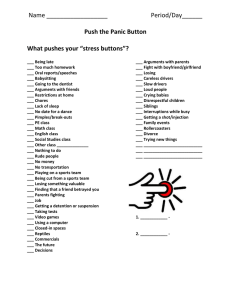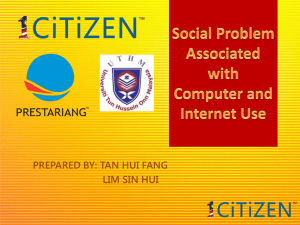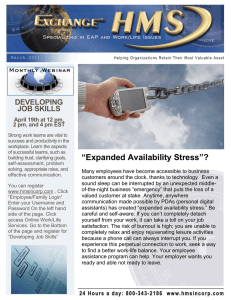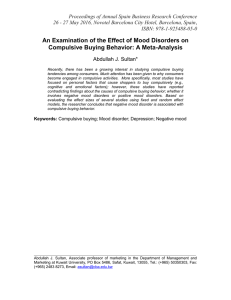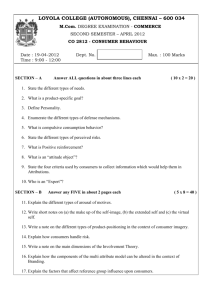OVERCOMING COMPULSIVE BEHAVIORS
advertisement
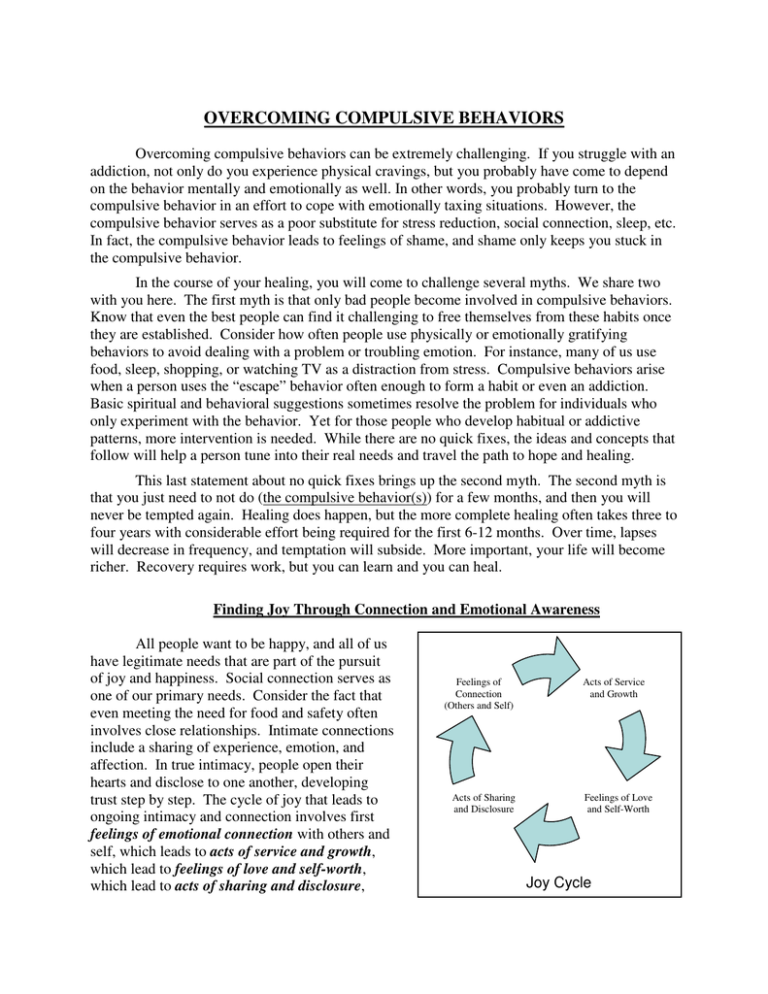
OVERCOMING COMPULSIVE BEHAVIORS Overcoming compulsive behaviors can be extremely challenging. If you struggle with an addiction, not only do you experience physical cravings, but you probably have come to depend on the behavior mentally and emotionally as well. In other words, you probably turn to the compulsive behavior in an effort to cope with emotionally taxing situations. However, the compulsive behavior serves as a poor substitute for stress reduction, social connection, sleep, etc. In fact, the compulsive behavior leads to feelings of shame, and shame only keeps you stuck in the compulsive behavior. In the course of your healing, you will come to challenge several myths. We share two with you here. The first myth is that only bad people become involved in compulsive behaviors. Know that even the best people can find it challenging to free themselves from these habits once they are established. Consider how often people use physically or emotionally gratifying behaviors to avoid dealing with a problem or troubling emotion. For instance, many of us use food, sleep, shopping, or watching TV as a distraction from stress. Compulsive behaviors arise when a person uses the “escape” behavior often enough to form a habit or even an addiction. Basic spiritual and behavioral suggestions sometimes resolve the problem for individuals who only experiment with the behavior. Yet for those people who develop habitual or addictive patterns, more intervention is needed. While there are no quick fixes, the ideas and concepts that follow will help a person tune into their real needs and travel the path to hope and healing. This last statement about no quick fixes brings up the second myth. The second myth is that you just need to not do (the compulsive behavior(s)) for a few months, and then you will never be tempted again. Healing does happen, but the more complete healing often takes three to four years with considerable effort being required for the first 6-12 months. Over time, lapses will decrease in frequency, and temptation will subside. More important, your life will become richer. Recovery requires work, but you can learn and you can heal. Finding Joy Through Connection and Emotional Awareness All people want to be happy, and all of us have legitimate needs that are part of the pursuit of joy and happiness. Social connection serves as one of our primary needs. Consider the fact that even meeting the need for food and safety often involves close relationships. Intimate connections include a sharing of experience, emotion, and affection. In true intimacy, people open their hearts and disclose to one another, developing trust step by step. The cycle of joy that leads to ongoing intimacy and connection involves first feelings of emotional connection with others and self, which leads to acts of service and growth, which lead to feelings of love and self-worth, which lead to acts of sharing and disclosure, Feelings of Connection (Others and Self) Acts of Sharing and Disclosure Acts of Service and Growth Feelings of Love and Self-Worth Joy Cycle which lead to deeper emotional connection. This joy cycle is filled with close connection with trusted others. Joy comes from love, and love is all about relationships. Appreciate the importance of being connected to yourself; that is, being tuned into your emotions whether the emotions are pleasant or distressing. You may have become expert at numbing out or distracting yourself when distressing feelings arise. Emotional awareness will lead you to connect and reconnect with important others and will lead you to promote growth in others and in yourself. Fulfilling legitimate needs always requires some effort and often takes time before the social, emotional, mental, physical or spiritual need is fully met. Coping with the sometimes unpleasant wait requires use of healthy coping strategies. Unfortunately, you may have begun to use compulsive behaviors in an attempt to fill the need inside. While these counterfeits never really meet the need, the brain responds to addictive stimuli by developing deeply rutted “pathways.” Strugglers thus fall into the rut of using the short-lived pleasure of the compulsive behavior to escape the distress of an unmet need. However, the compulsive behavior leads not to joy but misery—a compulsive cycle of misery. The compulsive cycle begins with feelings of isolation. Feelings of isolation include feeling lonely, feeling rejected or abandoned, or feeling that you are unworthy or incapable of being loved. As you experienced these distressing feelings at some time in the past, you may have stumbled into or been introduced to the compulsive behavior. You likely began to notice that the physical or emotional sensations temporarily blocked your awareness of emotional isolation. Over time, you turned to this escape strategy more often until a habit was formed. Because these actions provide pleasure, yet poison your soul and your relationships, they are called acts of self-indulgence. Over time, you need a more frequent and intense “fix” of your compulsive behavior to cover up the feelings of isolation and distress. This escalation of use gives rise to feeling more out of control as well as to neglecting or disrespecting family and friends. Your sense of diminished self-control and quality of life leads to the next step in the compulsive cycle: feelings of shame. After the act of self-indulgence, you likely experience an intense emotional let down, characterized by regret, sadness, discouragement, guilt, and intense shame. The feelings of shame and self-hatred move you to the next step in the cycle, that of acts Feelings of Acts of of concealment. A person who struggles with an Shame/Self-Hate Concealment addiction almost always copes with the shame through the use of deception, designed to hide the addiction. The deception then becomes a way of life, as more and more lies are required to disguise Compulsive Cycle the compulsive cycle. After a while, you may have developed a kind of double identity: a “good” self and a “bad” self. You often see the bad self as your real self. The thought of sharing this problem openly with your spouse, bishop, parent, or close friends often feels completely overwhelming. The concealment and hiding lead to more emotional and spiritual isolation—the original conditions that led you to acting out—and the cycle begins again. Feelings of Isolation Acts of SelfIndulgence Remember, the driving forces of an addiction problem are often deficits in intimate social connection and emotional awareness. Some strugglers minimize these deficits, assuming that they experience real intimacy, because they do have relationships with family, friends, or acquaintances. These people in the struggler’s life often see the deficits and feel the emotional distance much more clearly than does the individual himself. To exit the compulsive cycle and reenter the joy cycle requires significant effort. You will need to catch yourself in the compulsive cycle and “tune back in,” so to speak. An outline for an effective intervention follows. However, we will first address the willpower approach. Solutions False Hope: The Hold Your Breath Strategy Most people make a concerted effort to overcome compulsive behaviors. Willpower becomes the one and only tool used to fight the behavior. A man may say to himself: “OK, that’s it! I’m simply not going to (compulsive behavior) any more.” He determines that he will be more disciplined and will try harder! It is as though he vows to hold his breath and never inhale again. Strugglers hold their breath in two ways. 1) Numbing out feelings AND 2) Continuous distraction (e.g., workaholic) A struggler then shuts down awareness of social or emotional needs, figuring that he may be able to avoid lapsing back into compulsive behavior. He then takes a big gulp of air, and holds it as long as he can. But all the willpower in the world will not prevent him from eventually gasping for life-sustaining air again. The legitimate personal and social needs become more pressing and more difficult to ignore. He does have needs, especially for close social connection with trusted others. Moreover, the stress of denying needs increases the likelihood of going back to the compulsive behavior. He eventually slips back into the compulsive cycle. This relapse becomes discouraging, because he has tried with all of his might to stop the behavior. He may wonder why he can give his best effort only to fall short. He may assume that he is beaten, broken, and bad—a hopeless case. Real Solution: Finding Joy through Tuning into the Right Signal A real solution to overcoming these compulsive patterns in a person’s life requires learning to breathe and to live. In other words, you learn to enter the joy cycle and meet needs in healthy ways. We refer to this intervention as the ATM strategy. ATM stands for Admit out loud that you are being tempted, Tune into your emotional state, and Meet the need in a healthy and timely way. The following section provides some detail about ATM. ATM - The 3 Step Intervention: You can take back control of your life instead of living life on “cruise control.” The three steps to taking back control of your life are represented by an acronym: ATM. Note that each step is necessary to succeed. STEP ONE: ADMIT – Admit that you are feeling tempted. The moment you feel the urge to act out, you say out loud to yourself (or at least verbalize it in your mind if you are not alone): “I feel like (compulsive behavior) right now.” You now have conscious awareness of the urge. You now have a few moments to use your agency to regain your freedom. STEP TWO: TUNE IN – You next tune into the feeling or emotional state that the temptation is covering up. Know that numbing out and staying busy have also been hiding the emotional state from yourself. As you begin to learn to tune in, you may need to look at the BEST BELT list of emotional states (see next section) to be able to identify the healthy need that needs to be met. If you want to succeed, you would be wise to memorize BEST BELT well, so you can review it even in moments of temptation. Also pay attention to your physical body for clues to what you are feeling. For example, muscle tension in your neck and shoulders and a “heavy” feeling in your chest can signal stress or anxiety. If you struggle at first to identify the emotional states, consider contacting a member of your team to help you talk it through and tune in. STEP THREE: MEET THE NEEDS – You then should ask yourself “What can I do right now about my stress (or other current emotional state)?” Find a healthy way to meet the need. There are often two or three needs that may currently need your attention. You now have a choice regarding your action, instead of just drifting into doing the compulsive behavior as if on autopilot. Part of meeting needs in healthy ways involves learning to tolerate some degree of distress. It is unrealistic to expect that there is no stress, boredom, pain or turmoil in your life. Distress is one of life’s teachers, and you can learn to tolerate it. Remember to act to meet the need in a timely way rather than just avoiding the situation. Avoidance leads to numbing out or to simple distraction, in other words, holding your breath. Another part of meeting needs in healthy ways requires recognizing and learning from patterns, which then leads to proactively meeting needs in a timely manner before they reach a crisis point. Please refrain from urgently pressuring yourself to quickly learn the lesson. Rather, observe the pattern, so that you can learn from it and implement the learning in your life. Note that as temptations decrease in frequency over time, you will learn to naturally tune into your emotional state and actively meet the need or, more often, the needs. Learn to visualize your victories beforehand in your efforts to meet the needs in a healthy and timely way. The BEST BELT Emotional States & Healthy Ways to Meet Needs: In most cases, acting out has more to do with legitimate emotional states rather than false notions such as “I am just a bad or perverted person.” When a person stops to identify his emotional state, he takes himself off “cruise control.” He can then choose healthy behaviors and eventually reclaim his freedom, freedom from the compulsive behavior. For you to succeed in using the ATM strategy, you would be wise to first open your mind to the possibility that there are times of greater vulnerability. The more aware you are of these times, the more often you will begin to make decisions that will help you heal. Two acronyms will help you remember these emotional states. The first acronym is BEST. BEST stands for Body neglect, strong Emotions, Stress, and Tiredness. The second acronym is BELT. BELT stands for Boredom, Esteem issues, Loneliness, and Trials. The following paragraphs explain both the emotional states and the corresponding strategies to meet needs in healthy ways. Body neglect. When you are not taking care of your body the way you should with food or exercise, you may be more vulnerable. You will likely feel sluggish from inactivity. You may also experience hunger and headaches from skipping meals or a poor diet. Meet the need by eating three nutritious meals a day. Also, exercise for 20-30 minutes four or more times a week. If you are ill, do the things you can to help your body recover from illness. Emotional distress. When you do not manage strong emotions in a healthy way, you increase the risk of lapsing into compulsive behaviors. There is a broad array of emotions. The major categories are love, joy, surprise, relief, hope, anger, fear, sadness, disgust, guilt, and shame. Each feeling or emotion serves a motivational purpose. Each one is meant to move us to build or repair relationships, to promote growth in others or self, or to protect others or self. (See the Emotions as Teachers handout for more details). Understand that even the unpleasant emotions like loneliness, frustration, or fear serve a motivational purpose. For example, we feel frustrated when someone has offended us or interfered with a personal goal. To follow the motivational purpose, we need to communicate with that person to (1) get an apology, (2) set a limit, or (3) discover that we have perceived an offense where there was none or none intended. Forgiveness can then follow. Note that anger, fear, and sadness were meant to be experienced only at moderate levels for brief periods. Pray, relax, meditate, and put the issues in perspective to help take the edge off the intensity of an emotion while you follow the motivational purpose and resolve the problem. Note that long-term anger and fear destroy relationships and wear away at your physical and mental health. Keep the “volume level” on these two emotions in the mild to moderate range while you communicate with others and cope actively with the situation in a timely way. You may soon discover that there was less injustice or less threat than you had initially perceived. You may decide to forgive the offender for your own sake, because the cost of bitterness has been so high. Remember, too, that forgiveness does not necessarily imply trust. Stress. Stress is likewise a strong emotion, so follow the motivational purpose. Study for that upcoming test you are stressing about. Your stress will diminish, because the stress served its motivational purpose: to prepare you for the test. Also use relaxation to take the edge off of the intensity if the stress begins to disrupt your concentration or leads to restlessness. Tiredness. When you stay up too late at night or sleep away the day, it may result in you feeling run down which would increase your vulnerability. Instead, get the rest you need. Go to bed on time and get up on time. Avoid oversleeping. If you are physically tired, you may need to take a break before resuming your work rather than exhausting yourself. Boredom. There is an unpleasant restlessness to boredom. Do not sit with boredom for very long. It does not lead to healthy behaviors. Your mind is telling you that you need healthy, intellectual stimulation, either mental or social in nature. Read an engaging book. Engage in one of your hobbies. Play a musical instrument. Learn a language. Go visit a good friend. Esteem issues. When you feel low, you can feel tempted to escape the distress through the compulsive behavior. Understand the real need, which has two dimensions: (1) an appreciation of your identity as a child of God and (2) an appreciation of the fact that you do have something to offer. In regards to the first dimension, remember that God’s love is constant, stable, and unconditional. Shame-based hiding makes it difficult to feel His love. Turn to God and feel His love. In regards to the second dimension, take time to think of specific experiences that demonstrate your talents and qualities. While your confidence in these abilities may wax and wane, you may want to consider the possibility that your talents and strengths are more stable than you might think during moments of shame or distress. Engage in activities that use your strengths. You will come to realize that you do have something valuable to offer, especially to your family and friends. Loneliness. Loneliness leaves you vulnerable when you fail to follow the motivational purpose for the loneliness: connection. The loneliness is uncomfortable and is designed to get you to connect or feel emotional intimacy with another. You can connect with God, with family, or with close friends. You may also need to tolerate some discomfort while you develop deeper friendships and relationships. It can take time, but the connection is worth the effort. God will give you spiritual sustenance while you work on developing close relationships. Actively seek the Spirit and invite him to be a regular visitor in your life. Trials. Trials may include such things as unemployment, chronic illness, financial stress, or personal challenges. The need in such cases is endurance and perspective. Understand that trials come to everyone B absolutely everyone. Seek the support and resources you have in God, in family and friends, and in yourself. Also remember that gratitude is often the key to putting things into perspective. Make a list each day of things specific to that day for which you can be grateful. You will see more clearly as you practice gratitude daily. The Five Major Tasks of Healing 1) INFUSE HOPE / REDUCE SHAME – Hope increases motivation and keeps you going. Shame saps your energies and sends you into self-criticism. While there is a place for guilt, appropriate guilt guides you to hope in Christ and to learning from your lapses. You will maintain hope more easily and learn from your lapses when you focus on progress. For example, chart your progress for each month (e.g., November), rather than refer to the time that has passed since your last lapse. You will feel more positive and avoid the “binge” attitude. Healing is a journey much like a hike up a mountain with a gradual climb. While a slip is not desirable, you do not fall to the bottom of the mountain. You have lost only a few feet. Hop back up, dust yourself off, and begin climbing up the mountain again. You will get to the summit with consistent effort. 2) DO RELATIONSHIPS / REGULATE EMOTION / MAKE AMENDS / ACTIVELY FORGIVE – Relationships provide much of the meaning in our lives. Relationships involve some risk, and sometimes we get hurt. However, relationships also bring love, joy, and growth as well. Remember that emotions help us make sense of our relationships and help motivate us. Be wise and do not shut down unpleasant emotions. Instead, use strategies to regulate them, that is, to keep them at a manageable level. More importantly, though, understand and follow the healthy, motivational purpose behind the emotion. Our relationships with others offer joy and occasionally bring disappointment and frustration as well. Be careful not to expect others to be perfect or even nearly perfect. You too are not perfect. We all need the Atonement. When you hold a grudge against yourself or others, you take a dangerous detour from the path of healing. Connecting with others requires that you make amends to others you have wronged. Moreover, to receive strength from God, you need to forgive and pray for those people who have hurt you (sometimes yourself included). You may end up reconciling with the person, or you may end up setting limits to avoid getting hurt repeatedly. Regardless of the outcome, learn to forgive. Forgiveness binds our wounds and helps us heal. 3) SET AND KEEP BOUNDARIES – Know your boundaries. Identify what specific situations or signals increase the risk of lapsing into the compulsive behavior. Take steps to avoid those situations, so you do not have to exercise extreme willpower in the moment of temptation. For example, an alcoholic would be wise to (a) avoid the bar and (b) make new groups of friends. The following suggestions will help you follow through on keeping such boundaries. For example, use post-it notes around your home, your office, and your computer screen as visual reminders of your goals (e.g., notes with the acronyms ATM and BEST BELT). Also consider carrying a 3x5 card that lists your boundaries. On your 3x5 card, you might also include a plan for handling temptation. For example, you might write, “When temptation comes I will: (1) pray for strength, (2) remind myself to take it just one day or one hour at a time, (3) call a friend, (4) get out of the house or apartment, (5) get busy on a task, and (6) figure out what legitimate need should be addressed.” Your plan should include specific people, places and resources. 4) ANALYZE AND MANAGE LAPSES – You may have learned to suppress any thought about the actual lapses that occur. You may have become so skilled at suppressing such memories that you may have some difficulty remembering the details at first. Do not worry. With effort, you can start to remember the events surrounding the lapses. Remember too that while analyzing the lapses may be unpleasant for you, you can only learn how to manage and avoid the lapses through analyzing them. Healing is a process much like hiking a mountain. You make steady progress toward the summit, but the terrain is uneven. There are ups and downs on the path. Trust that as you learn from lapses you are still moving toward the summit. 5) ESTABLISH AND DRAW SUPPORT FROM YOUR TEAM – Set up a team of three or more people you trust to draw support from. These people should know about your compulsive behavior, so you do not have to partially conceal (see the Compulsive Cycle). Go to them in moments of temptation. Let them listen to you, encourage you, and help you see what you can do to meet your needs in healthy ways. Share not only your moments of temptation and struggle, but share your successes, concerns, hopes, and dreams as well. Spiritual Strategies and Conclusion Sometimes people take too limited a view of what constitutes a spiritual solution. For example, you may have said to yourself, “I just need to read my scriptures more,” or “I need to pray more intently and frequently.” You may have mistakenly assumed that you lacked faith, because the problem persisted in the face of more scripture study and prayer. Know that the strategies presented in this handout are compatible with divine truth and will further assist you in your healing. God has counseled that the intellectual, emotional, physical, and social dimensions of life are part of divine truth. In Section 88 of the Doctrine & Covenants, God even exhorts us to “seek out of the best books words of wisdom.” Thus, a wise person includes wisdom from all good and reliable sources when working to overcome compulsive behavior. Invite the Lord to walk with you as you walk the path of healing. The Spirit’s influence will lift you up when you tune in. Engage in activities that invite the Spirit. Spend time at the temple. Watch a church video or listen to uplifting music. Sing a hymn or read your scriptures. Read and ponder the conference sermons from church leaders. Lose yourself in service to others. Pray meaningfully. Review your Patriarchal blessing. Counsel with your bishop. Receive priesthood blessings as needed. Make these activities meaningful, so that you can feel the Spirit. To conclude, perhaps the most important thing to remember is that Christ’s Atonement applies to you. His Atonement offers you both cleansing and strengthening powers. Persist in your efforts to heal, and constantly acknowledge your dependence upon the Lord. Even when your progress slows or you stumble a bit, remember that God is with you and is pleased with your sincere efforts. Elder Packer has stated, “It is contrary to the order of heaven for any soul to be locked into compulsive immoral behavior with no way out.” You can heal. It may not be easy, but you can walk the path of healing. Adapted and developed (09/2007) by Doug Craig, Reed Hendricks, Dan Barnes, and Rebecca Jorgensen. Some concepts are taken from “Breaking the Cycle of Compulsive Behavior” by John and Martha Beck, “Willpower is Not Enough” by A. Dean Byrd and Mark D. Chamberlain, “Pornography Use: Consequences and Cures,” by Paul James Birch, “Homosexuality: Symptoms & Free Agency” by Scott & Kae Andersen, and “Human Intimacy: Illusion and Reality” by Victor L. Brown, Jr. BEST BELT What can I do about taking care of my BODY instead of acting out? 1. 2. 3. What can I do about my upsetting EMOTIONS instead of acting out? 1. 2. 3. What can I do about my STRESS instead of acting out? 1. 2. 3. What can I do to deal with my TIREDNESS instead of acting out? 1. 2. 3. What can I do to deal with my BOREDOM instead of acting out? 1. 2. 3. What can I do with my poor self-ESTEEM/self-worth instead of acting out? 1. 2. 3. What can I do about my LONELINESS instead of acting out? 1. 2. 3. What can I do to deal with my TRIALS instead of acting out? 1. 2. 3.
